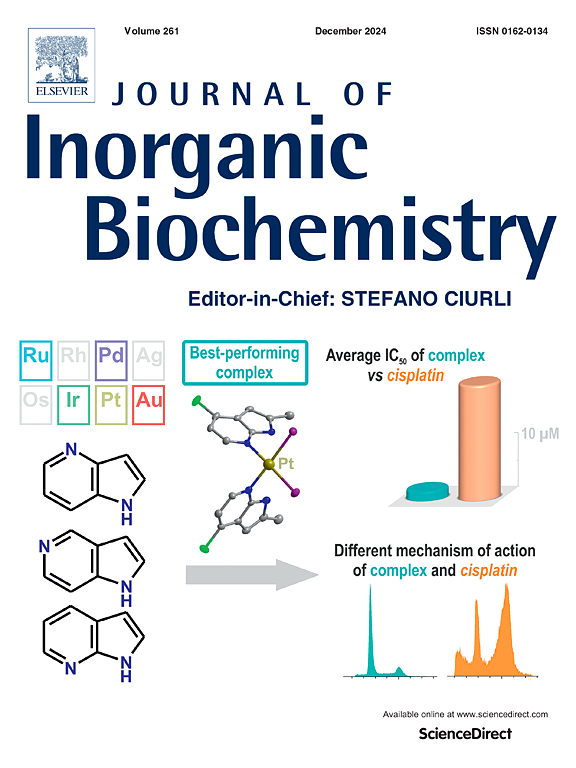Structural related oxidovanadium(IV)-flavonoid complexes. Influence on their anticancer effects
IF 3.2
2区 化学
Q2 BIOCHEMISTRY & MOLECULAR BIOLOGY
引用次数: 0
Abstract
Flavonoids, known for their antioxidant properties in plants, can also act as pro-oxidants in cancer cells, an effect that intensifies when coordinated with metal cations. Among them, oxidovanadium(IV) (VO) complexes with flavonoids have shown promising anticancer potential, following a clear relationship of the ligand structure with the activity. Quercetin and troxerutin share a common core structure; however, in troxerutin, four of the five hydroxyl (-OH) groups of quercetin are blocked, which may influence its metal coordination properties. In this study, we synthesized and fully characterized the VOtroxerutin complex using FTIR, EPR, UV–Vis, and reflectance spectroscopies, along with elemental, thermal, and conductivity analyses. Additionally, we prepared the reported VOquercetin complex, which shares the same coordination sphere as VOtroxerutin, to explore a relationship between the structure of the complexes and their activities. Their anticancer potential was tested through in vitro cytotoxicity assays against the A549 human lung cancer cells and HaCaT normal human keratinocytes. Both complexes exhibited anticancer activities (viability inhibition at 100 μM: 32.1 %, VOtroxerutin; 39.5 %,VOquercetin) and selectivity, highlighting their therapeutic potential. Notably, their pro-oxidant effects were activated upon incubation with cancer cells, leading to oxidative stress-induced cytotoxicity and mitochondrial membrane disruption. Further comparisons with the VOrutin complex provided additional insights into the correlation between anticancer activity and the coordination environment of the VOFlavonoid complexes. Additionally, we evaluated the safety profile of VOtroxerutin, finding no acute toxicity or mutagenic effects, supporting its potential as a targeted anticancer therapy with normal cells viability inhibition only at 100 μM (10 %).

结构相关的氧化钒(IV)-类黄酮配合物。对其抗癌作用的影响
黄酮类化合物,以其在植物中的抗氧化特性而闻名,也可以作为癌细胞的促氧化剂,当与金属阳离子配合时,这种效果会增强。其中,氧化钒(IV) (VO)与黄酮类化合物配合物显示出良好的抗癌潜力,其配体结构与活性有明确的关系。槲皮素和曲克芦丁具有共同的核心结构;然而,在troxerutin中,槲皮素的5个羟基(-OH)基团中有4个被阻断,这可能影响其金属配位性能。在这项研究中,我们利用FTIR、EPR、UV-Vis和反射光谱,以及元素分析、热分析和电导率分析,合成并充分表征了VOtroxerutin复合物。此外,我们制备了与VOtroxerutin具有相同配位域的VOquercetin配合物,以探索配合物的结构与活性之间的关系。通过对A549人肺癌细胞和HaCaT正常人角质形成细胞的体外细胞毒性试验,检测了其抗癌潜力。两种配合物均表现出抗癌活性(在100 μM时活性抑制:32.1%,VOtroxerutin;39.5%,VOquercetin)和选择性,突出了它们的治疗潜力。值得注意的是,它们的促氧化作用在与癌细胞孵育后被激活,导致氧化应激诱导的细胞毒性和线粒体膜破坏。进一步与VOrutin复合物进行比较,进一步深入了解了vo黄酮类化合物的抗癌活性与配合环境之间的关系。此外,我们评估了VOtroxerutin的安全性,发现没有急性毒性或致突变作用,支持其作为靶向抗癌治疗的潜力,仅在100 μM(10%)下抑制正常细胞活力。
本文章由计算机程序翻译,如有差异,请以英文原文为准。
求助全文
约1分钟内获得全文
求助全文
来源期刊

Journal of Inorganic Biochemistry
生物-生化与分子生物学
CiteScore
7.00
自引率
10.30%
发文量
336
审稿时长
41 days
期刊介绍:
The Journal of Inorganic Biochemistry is an established international forum for research in all aspects of Biological Inorganic Chemistry. Original papers of a high scientific level are published in the form of Articles (full length papers), Short Communications, Focused Reviews and Bioinorganic Methods. Topics include: the chemistry, structure and function of metalloenzymes; the interaction of inorganic ions and molecules with proteins and nucleic acids; the synthesis and properties of coordination complexes of biological interest including both structural and functional model systems; the function of metal- containing systems in the regulation of gene expression; the role of metals in medicine; the application of spectroscopic methods to determine the structure of metallobiomolecules; the preparation and characterization of metal-based biomaterials; and related systems. The emphasis of the Journal is on the structure and mechanism of action of metallobiomolecules.
 求助内容:
求助内容: 应助结果提醒方式:
应助结果提醒方式:


